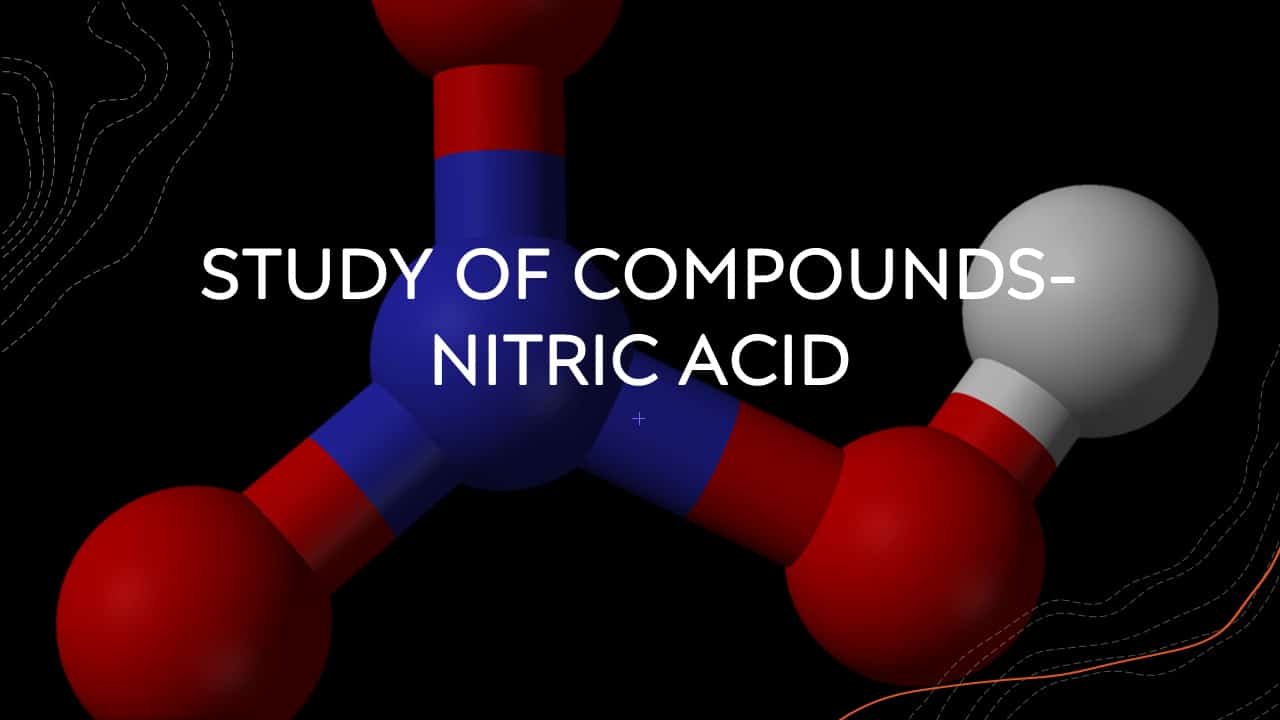STD X – STUDY OF COMPOUNDS NITRIC ACID – EINSTEIN
About Course
In this section will learn this following chapters:
1.NITRIC ACID
Last Updated:October 17, 2023
0 (0 Ratings)
Share Course
Page Link
Share on social media

Description
Preparation of Nitric Acid
Nitric acid (HNO3), also known as aqua fortis and spirit of niter, is a highly corrosive mineral acid.
The synthesis of nitric acid was first recorded ca. 800 AD by the alchemist Jabir ibn Hayyan, a.k.a. Gerber.
Formula: HNO3
Molar Mass: 63.01 g/mol
Density: 1.51 g/cm³
Boiling point: 83 °C
Melting point: -42 °C
This is a very strong acid with a suffocating and pungent odour, highly toxic to inhale, and corrosive to metals and tissues.
Nitric acid is one of the acids in acid rain. Nitrogen Oxide emitted from vehicle engines mix with water vapour in the air and turns into nitric acid. This nitric acid falls from the sky as acid rain.:
This acid is prepared by reaction of nitrogen dioxide (NO2) with water.The commercial production of nitric acid is by oxidizing anhydrous ammonia to nitric oxide, in the presence of a platinum catalyst at a high temperature (Ostwald process).
In this chapter, we will learn in detail about lab preparation of nitric acid.
Physical properties
Colourless liquid (commercial nitric acid is yellowish brown) with suffocating smell and acidic taste
. Fumes in air and is always placed in a stoppered bottle
. Soluble in water in all proportions
Corrosive can cause blisters on the skin. Reacts with the protein on skin to form xanthoproteic acid which stains the skin yellow
When oxides of nitrogen dissolve in rain water, they come down to earth as acid rain
Oxidising properties of nitric acid
Being a powerful oxidizing agent, nitric acid reacts violently with many non-metallic compounds. Reactions may be explosive
Oxidizing properties are because of nascent oxygen which is formed during decomposition of acid
Nitric acid reacts with metals to form nitrates and is itself reduced to NO, N2O, NO2 or NH3 (which further reacts with HNO3 to give NH4NO3) depending upon the concentration of the acid, activity of the metal and the temperature of the reaction
Free
Free
Free access this course
-
LevelIntermediate
-
Total Enrolled6
-
Last UpdatedOctober 17, 2023
Hi, Welcome back!
Material Includes
- ⭐ DAILY Test and Quiz with instant tracking for progress
- 👋 Monthly Parents and Tutor interactions
- 🌷 Expert monitoring of student's learning progress
- 👨👩👧👧 Daily communication over call, whatsapp and mail
- ✍10 downloadable resources
- ⌛Access for entire Academic Year
- 📱Access on mobile and Desktop
- 📋Assignments and review of the same
- 💡Tests and Correction by Board paper checkers
- 🏅Certificate of completion and Live tracking with Grade book
Course Duration:
0
Course level:Intermediate
Enrolled:6
About Course
In this section will learn this following chapters:
1.NITRIC ACID
Course Curriculum
NITRIC ACID – 18 MAY – PREPARATION OF HNO3
-
NITRIC ACID – PHYSICAL CLASS – LABROTORY PREPARATION OF NITRIC ACID
20:54 -
NITRIC ACID – SUPPORT MATERIAL – NITRIC ACID PREPARATION OF NITRIC ACID
00:37 -
NITRIC ACID – PHYSICAL CLASS – PREPARATION OF NITRIC ACID OSTWALDS PROCESS
21:41 -
NITRIC ACID – PHYSICAL CLASS – CHEMICAL PROPERTIES OF NITRIC ACID
23:06 -
NITRIC ACID – SUPPORT MATERIAL – NITRIC ACID PROPERTIES
01:18 -
NITRIC ACID – SUPPORT MATERIAL – NITRIC ACID – USES
00:27 -
NITRIC ACID – PHYSICAL CLASS – TESTS FOR NITRIC ACID
16:07 -
STUDY OF COMPOUND – NITRIC ACID – ONLINE CLASS – COMPLETE RECAP
01:06:51
Student Ratings & Reviews

No Review Yet

